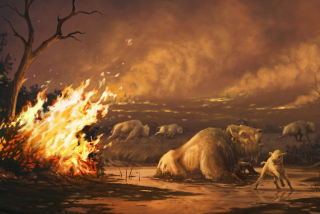Study Dates Eruption That May Have Killed 80% of Animals
- Share via
A volcanic eruption that lasted a million years and flooded Siberia with mile-deep lava may have killed 80% of the world’s animals--an extinction far more deadly than the later one that claimed the dinosaurs, researchers concluded.
Precise dating of geologic samples that mark the extinction 250 million years ago show that the massive die-off occurred about the same time a volcanic eruption blanketed Siberia with lava and filled the global sky with chemicals, scientists report today in the journal Science.
“We have been able to put a very precise date on the extinction boundary [formation], something that has not been done before,” said Mark Richards, a UC Berkeley professor of geophysics and co-author of the study.
The date of that extinction, which marks the shift from the Permian to Triassic period, was the same, within a few thousand years, as the Siberian eruptions. Richard said basalt lava poured out of fissures in Siberia and flowed like scorching cookie dough across thousands of square miles. Up to a cubic mile of lava belched out annually for about a million years, he said.
Paul Renne, director of the Berkeley Geochronology Center and a co-author, said the extreme volcanic activity may have set off events that killed 90% of all marine species and 70% of all land vertebrates, along with most of the terrestrial plant life.
“In extreme cases such as this one, volcanoes in and of themselves appear to be sufficient to wipe out life on the planet,” Renne said in a statement.
The Permian die-off has been described by paleontologist Stephen Jay Gould as “the granddaddy of all extinctions”--far more deadly than the events that killed the dinosaurs 65 million years ago.
Animals killed in the Permian extinction were less well-known than the dinosaurs. The victims were such creatures as clams, sponges and trilobites, a type of armored sea animal.
The dinosaur extinction has been associated with the collision on Earth of a massive meteor or comet. But a huge volcanic eruption occurred about the same time, forming a deposit in India called the Deccan traps.
More to Read
Sign up for Essential California
The most important California stories and recommendations in your inbox every morning.
You may occasionally receive promotional content from the Los Angeles Times.













